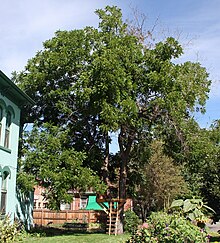| Thousand cankers disease | |
|---|---|
 A walnut tree in Denver, Colorado affected by Thousand cankers disease. | |
| Common names | TCD |
| Causal agents | Geosmithia morbida |
| Hosts | Walnut trees (Juglans sp.) |
| Vectors | walnut twig beetle (Pityophthorus juglandis) |
| EPPO Code | GEOHMO |
Thousand cankers disease (TCD) is a recently recognized disease of certain walnuts (Juglans spp.). The disease results from the combined activity of the walnut twig beetle (Pityophthorus juglandis) and a canker producing fungus, Geosmithia morbida.[1] Until July 2010 the disease was only known to the western United States where over the past decade it has been involved in several large scale die-offs of walnut, particularly black walnut, Juglans nigra. However, in late July 2010 a well-established outbreak of the disease was found in the Knoxville, Tennessee, area. This new finding is the first locating it within the native range of its susceptible host, black walnut. In 2013, an outbreak was found in the Veneto region of Italy, where the disease has been found on both black walnut and English walnut.[2]
- ^ Kolarik, M.; Freeland, E.; Utley, C.; Tisserat, N. (2011). "Geosmithia morbida sp. nov., a new phytopathogenic species living in symbiosis with the walnut twig beetle (Pityophthorus juglandis) on Juglans in USA". Mycologia. 103 (2): 325–332. doi:10.3852/10-124. PMID 20943528. S2CID 35496500.
- ^ Montecchio, L.; Vettorazzo, M.; Faccoli, M. (2016). "Thousand cankers disease in Europe: an overview". EPPO Bulletin. 46 (2): 335–340. doi:10.1111/epp.12301. ISSN 0250-8052.